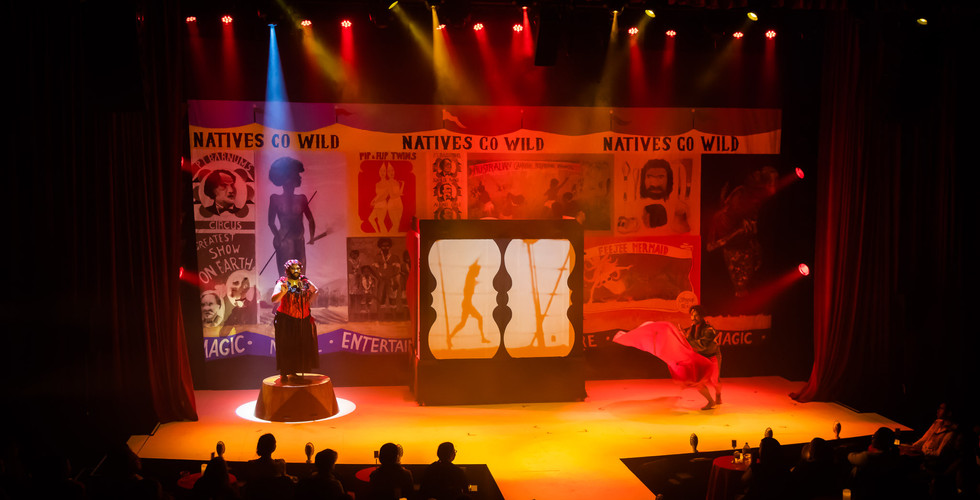Review: Natives Go Wild at the Sydney Opera House
- Theatre Travels

- Oct 24, 2019
- 4 min read
By Naomi Hamer
Where the runaways are taking over the night sings the ensemble of The Greatest Showman. While Barnum and Bailey Circus held the balance of power in the late nineteenth and early twentieth centuries, in Natives Go Wild the first nations people, who were in some cases kidnapped, stolen and taken advantage of (to put it mildly), finally have control of their own narrative. Written and created by Rhoda Roberts, the head of Indigenous Programming at the Sydney Opera House, Natives Go Wild is a celebration of and a rebellion against the people and forces that profited off and exploited first nation people for far too long. We were all so entranced by The Greatest Showman that we didn’t look beyond the red curtains. And whilst everyone fell in love with the movie musical starring Hugh Jackman as P.T Barnum, Natives Go Wild flips this narrative and exposes the dark and mostly hidden histories of the mistreatment of first nation people in show business.
From the opening moments we are introduced to the anonymous savage and exotic roles first nations people from Australia and the wider South Pacific played within the circus. With Rotuman musician and performer Samuela Taujave and Mer Island dancer, Waangenga Blanco enters the stage in a grass skirt and a small red and yellow tasseled scarf. Blanco moves across the stage with a handful of eucalyptus leaves in a smoking ceremony that welcomes us to the space and slowly fills the three tiered studio theatre. We’re greeted by our ringmaster, the inimitable Mika Haka, a queer Maori performance artist who shines brightly, commanding the stage. Throughout the evening it is Haka who guides us through the atrocities and mistreatments that circuses like Barnum and Bailey performed. This included the fact that most people from the South Pacific were presented as savages and Native Americans rather than from their own culture or like Con Colleano, one of the highest paid circus performers and most successful tightrope walkers, who was presented as an exotic Spaniard. Niuean contortionist, aerialist and dancer Josephine Mailisi stole the show with her sky high aerial feats and her beautiful dancing as the Feejee Mermaid accompanied by the soulful vocals of Seini Taumoepeau who performed as the song woman and bearded lady. And our comic relief for the evening came from Beau James of the Mununjali clan of the Ygambeh Nation in South East Queensland who has over 25 years of experience as a circus artist, physical comedian and cabaret performer. From swallowing a long balloon to escaping from a straitjacket like the clown best known as Little Nugget, James’ slipped between being the butt of the joke one minute to whipping a rose held between an audience member’s legs the next.
Between the glitz and the glam of the riotous circus acts and cabaret was a solemn moment of remembering both past and present performers who have died while off country and away from their homelands. As recently as Wangkatjunka actor Ningali Lawford-Wolf who passed away in August 2019 while performing at the Edinburgh International Festival. And Tambo, a Palm Islander who was recruited for Barnum and Bailey’s “Aboriginal Cannibal Boomerang Throwers”, dying of pneumonia within a year of joining the circus. Worse still, Barnum had his body embalmed and displayed as a side show curiosity. It was only in 1994 that his body was repatriated back to Palm Island, many performers having similar fates or with their origins unknown in what was known as the human zoo.
With direction from Chelsea McGuffin and assisted by assistant director and set and lighting designer, Mark Howlett whose set was a pastiche of vintage circus logos and slogans and clown faces mixed into a palette of red and yellow with splashes of blue, red and yellow light to transform the scene. A portable circus cage was pushed and pulled across the stage and used as a base for projections of photos and videos from the circus, from Feejee Mermaids to tightrope performers. It transformed into a prison and human cage - an eerie reminder that the circus was often just as much a human zoo as it was a place of entertainment. Capturing audience imaginations and holding captive it’s performers simultaneously. Academy award winning costume designer Tim Chappel’s costumes were a cabaret and vaudeville delight with flourishes of fishnets, sequins and ringmaster jackets, corsets and fishnets amongst more traditional tropes of grass skirts and leotards. Music Director Damian Robinson had his work cut out for him arranging a completely original soundtrack and new music which brought the show to life.
Natives Go Wild reclaims the forgotten histories of the exploitation and human trafficking of first nation people from the South Pacific to imagine an evening that has just as much pizazz and sparkle as any cabaret without ever becoming didactic. With only four weeks rehearsals for such an original and provocative cabaret and circus full of sideshow curiosities, I can only imagine what a longer rehearsal period and lead up time would have offered this exciting and at times confronting production. The most confronting part perhaps being that I hadn’t thought about the first nation people exploited by the circus to begin with?
Natives Go Wild is playing at the Sydney Opera House from Tuesday to Sunday 22 - 27 October 2019.
Image Credit: Anna Kucera
All opinions and thoughts expressed within reviews on Theatre Travels are those of the writer and not of the company at large.














































